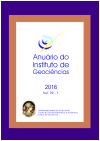Determination of Climatological Profile of Santo Antônio de Pádua Municipality, Rio de Janeiro State and its Applicability to Degraded Areas Recovery
DOI:
https://doi.org/10.11137/2016_1_05_12Keywords:
Climate, desertification, reforestation, Santo Antônio de Pádua MunicipalityAbstract
The municipality of Santo Antonio de Padua, located in the northwest State of Rio de Janeiro-RJ has been and iscurrently characterized by economic activities highly degrading the environment. As a consequence of process, it is possibleto highlight the decline of springs, reduced biodiversity, increased frequency of floods and changes in temperature andwater balance, culminating in a process of desertification in the region.The present study was conducted through analysisof historical series of temperature (1980-1995) and (2001-2010) precipitation (1980-1985) and determined the climaticclassification of the municipality according to Thornthwaite methodology, which has also been used in calculating theclimatic water balance to estimate water availability in the municipality. The present study aimed to investigate the trendsof climatic parameters and their impact on the physical environment, as well as its applicability in planning the recoveryof degraded lands. According to the analysis of the water balance and the historical series of temperature and rainfall, theregion presents marked water deficit during the winter, when there is an upward trend of average monthly temperatures.Knowing the climatological profile has allowed us to define the best methodological alternatives for reforestation of theregion, demonstrating the importance of evaluating these parameters in any kind of recovery planning forest.Downloads
Download data is not yet available.
Downloads
Published
2017-02-15
How to Cite
Brandão, C. B. (2017) “Determination of Climatological Profile of Santo Antônio de Pádua Municipality, Rio de Janeiro State and its Applicability to Degraded Areas Recovery”, Anuário do Instituto de Geociências. Rio de Janeiro, BR, 39(1), pp. 5–12. doi: 10.11137/2016_1_05_12.
Issue
Section
Article
License
This journal is licensed under a Creative Commons — Attribution 4.0 International — CC BY 4.0, which permits use, distribution and reproduction in any medium, provided the original work is properly cited.















